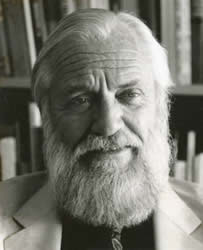

|

|
IN MEMORIAM
David Hooson
Professor of Geography, Emeritus
UC Berkeley
1926 – 2008
David Hooson, emeritus professor of geography, passed away at age 82 on May 16, 2008. He died doing what he loved, taking his morning constitutional swim in Tomales Bay, near his home in Point Reyes Station, California. David was quite fit right up to the end, and he enjoyed a busy and happy retirement with his wife of 26 years, Margaret Mackenzie Hooson. As Margaret put it, “He left life with the loose ends tied up, his family at peace…He had completed his work; he was not planning any new projects.” He is also survived by son Roger and daughter Clare, both of whom live in the Bay Area, a brother and sister in Britain, and by his first wife, Alison Rayner-Hooson.
Professor Hooson taught at the University of California, Berkeley, from 1964 to 1997, and was a prominent member of the geography faculty in the era following the retirement of Carl Sauer. He served as chair of geography from 1970 to 1975, and oversaw a push to diversify the department, in terms of ideas and personnel (he hired the first female and African-American professors). He was often the peacemaker in a faculty divided in outlook and interests—though, as Professor James Vance once said, “In the end, David always gets his way.” Hooson went on to serve as dean of social sciences from 1977 to 1980, and chair of the Berkeley Division’s Committee on the Status of Women and Ethnic Minorities from 1981 to 1982. At retirement, he received the Berkeley Citation for meritorious service to the University.
Hooson was born on April 25, 1926, in the Vale of Clwyd in North Wales, and was always proud of his Welsh heritage, though to untrained American eyes, he seemed a consummate Englishman of the old school: convivial, soft-spoken, witty, and gracious. Hooson attended Oxford University and received his doctorate from the University of London. His first teaching job was at the University of Glasgow, but he soon joined the legions of British “scholarship boys” of the postwar generation who headed for the more open (and better paid) academic fields of North America. He began at the University of Maryland in 1956, then moved to the University of British Columbia in 1960, and finally to Berkeley in 1964. He liked to recall that he knew Berkeley was right for his Welsh constitution when, soon after arrival, he was invited to a colleague’s house during fog season and there was a fire burning in the fireplace in midsummer!
Professor Hooson’s specialty was the former Soviet Union, and his major published works were A New Soviet Heartland? (1964) and The Soviet Union: People and Regions (1966). He made many forays into the region for research and collaboration with colleagues on the other side of the Iron Curtain; always open-minded, he was the exceptional Soviet specialist who was not a Cold Warrior (he was always amused by the number of times Russians asked to photograph him, as age, a full beard, and greying hair gave him a resemblance to Karl Marx!). Hooson wrote many articles on the Soviet Union and East Europe, and was active in professional circles, joining fellow specialists at the annual meetings of the Association of American Geographers, the Institute of British Geographers, the American Geographical Society, and the International Geographical Union. He was involved for many years with the Center for Slavic and East European Studies on the Berkeley campus and served as its chair from 1967 to 1970. He was awarded a prestigious Guggenheim Fellowship in 1976.
Hooson also wrote and taught on the history of geography and geographic ideas. He was forever attuned to developments in the discipline, past or present, and he enjoyed initiating new students into the mysteries of the field he loved. He shared the long view of geographic thought with his former colleague Clarence Glacken but kept an open mind toward new ideas. Hooson chaired the Commission on the History of Geographic Thought of the International Union of the History and Philosophy of Science and the International Geographical Union, 1980-1988. His last book was the edited volume, Geography and National Identity (1994).
David Hooson loved teaching and was pleased with the large crowds of students he attracted to his wide-ranging courses on Geography of the Soviet Union, World Regions, and Geographic Thought. He always encouraged bright undergraduates to continue their studies and was a devoted mentor to graduate students (he claimed, proudly, that none of his students had ever failed to complete a dissertation). He continued teaching after retirement, first as emeritus lecturer at Berkeley and later through UC Berkeley Extension and the University of San Francisco’s lifelong learning program. The course he had just begun at the time of his death was titled, tongue-in-cheek, What Does it Take to Dominate the World?
David Hooson was a delightful colleague and a pillar of Berkeley geography over four decades. He was, most of all, a humane and honorable figure. He will be sorely missed.
Richard Walker